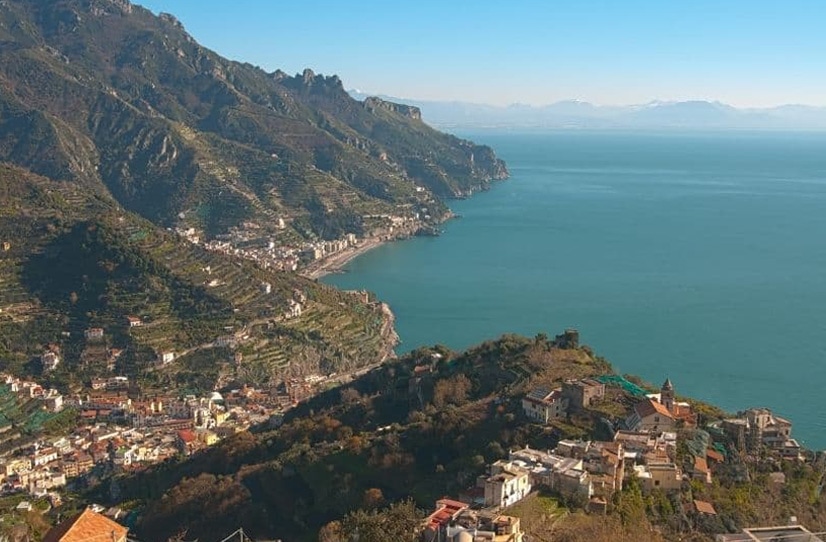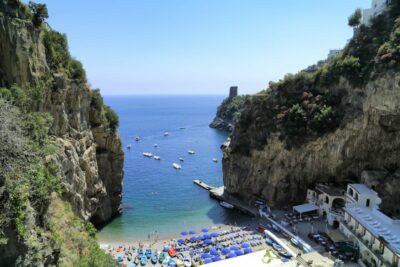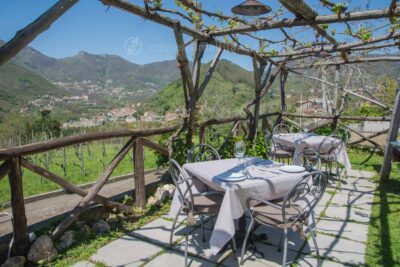The Amalfi Coast is not just sea and good food, but also magnificent landscapes. Put on a pair of comfortable shoes, backpack on your shoulders, and set off to discover the ancient hidden paths.
The SS163 is a scorching tongue of asphalt built in modern times, but moving inland, on those hills overlooking the sea, there are lanes traced by farmers and merchants.
Among gardens and lemon groves one can still meet goats and mules grazing blissfully and discover, beyond the green, the deepest blue of the sea. Trekking on the Amalfi Coast is an experience that is both different and unique.
Let us discover together which are the best known paths for spending a different day, far from the confusion typical of the Coast and of places crowded by mass tourism.
Indice dei contenuti
Trekking on the Amalfi Coast: the most famous itineraries
📍 The Path of the Gods

📏 8 km
🟡 medium difficulty
This is the most popular route among tourists, its name is not a coincidence. In fact, the landscape you will enjoy along the way is truly divine. There are two sections, one called “the high’ that leads from Salerno to Bomerano, and the other “the ‘ow” that leads from Bomerano to Nocelle (a hamlet of Positano), this route is 8 km long and is of medium difficulty.
After passing Colle Serra in the background, you can see the ‘Li Galli’ islands, the Sorrentine peninsula and Capri; then continue towards Li Cannati and again Nocelle and Montepertuso, until the stairway that descends to the beach of Positano.
All the routes have a shortcut, this one has two, the first from Praiano, towards the convent of San Domenico, the second is a descent towards Nocelle and Arienzo.
In spring and autumn, it is possible to stop and listen to a concert, before resuming the walk.
The ‘high’ path is more difficult and not recommended for those who suffer from vertigo. From Santa Maria di Castello in Bomerano, 659 metres above sea level, it climbs to 1079 metres at Capo Muro, and then descends again to Bomerano.
For further information, please refer to our complete guide dedicated to the Path of The Gods.
Discover all the guided excursions on the Path of the Gods
📍 Valle delle Ferriere
⌛ 3 hours
🟢 low difficulty
One of the most fascinating trekking routes on the Amalfi Coast is located between Amalfi and Scala, where the Valle delle Ferriere, crossed by the Canneto torrent, lies.
The atmosphere is typical of a canyon, with a special microclimate that has allowed the preservation of rare vegetation.
It is possible to walk the path in different directions, downhill starting from Minuta di Scala or the village of Pontone or uphill starting from Amalfi.
In the lower part, not far from Amalfi, we cross the Valle dei Mulini (Valley of Mills) where there are the remains of ancient paper mills and mills famous for paper processing, while ascending we enter the Valle delle Ferriere (Valley of the Ironworks), so called because of the presence of ancient iron-working areas.
Small rapids and waterfalls guard what has been a nature reserve since 1972. Another nearby route we have reviewed is the Vedette path.
Book your excursion to Valle delle Ferriere: experience a unique adventure!
📍 Montepertuso (Positano) – Conocchia – Monte S. Michele
⌛ 4 hours
🟡 average difficulty
The starting point for this trekking itinerary is the hamlet of Positano, Montepertuso.
After climbing up to the forest barracks, the panorama unveils itself without too many secrets to hikers; looking to the left, Montepertuso can still be seen, while at the far end is Vettica Maggiore, hamlet of Amalfi.
On the way, one can stop or continue on to Santa Maria di Castello to see the grotto with the Madonna, and again to Monte Sant’Angelo a Tre Pizzi, characterised by a decidedly wild landscape that is different from the one encountered on the rest of the trail.
Crossing the rocky heights, one arrives at the Conocchia crossroads and then climbs to 1444 metres, the highest peak, a natural terrace overlooking the great Gulf of Naples.
📍 The Praia Path: from Bomerano to Marina di Praia
📏 4 km
🟡 medium difficulty
From the central square of Bomerano, a hamlet of Agerola, walk along the mule track until you reach the grotto of Santa Barbara, then turn right onto the ancient Praia riverbed leading to Praiano and Vettica Maggiore, and then slide towards the coastal road.
One reaches Marina di Praia by taking the steps to cala di Rezzola near the church of San Luca.
📍 Maiori – Convent of S.Nicola – Minori (2 hours – low difficulty)

⌛ 2 hours
🟢 low difficulty
The Convento of S. Nicola is located between Maiori and Minori, atop a hill in the centre of the valleys of the Monti Lattari.
Although not very high, it allows you to enjoy spectacular scenery, with the peaks of Monte Sant’Angelo that light up when the sun rises, Monte Finestra, the Demanio mountains and the Avvocata.
In the centre is the valley of Reginna Minor and the little houses of Minori, to the west the rocky cliff where Scala and Ravello stand blissfully, to the east the valley of Maiori.
Departure is possible from both Minori and Maiori via several paths, among which we recommend the ‘Lemon Path‘ leading to the Torre village, along the way you will find clear directions to the convent.
📍 The osprey path

⌛ 40 minutes
🟢 low difficulty
Among the hikes to do, we recommend this rather short one that starts from the church of S. Elia in Furore, in Piazza del Carmine, and in 40 minutes takes you to the Furore Fjord.
The route is steep only in the initial part, but the exposure to the sea makes it pleasant. The final stop is the fishermen’s village made up of a small group of perched houses.
For those wishing to explore more of this splendid part of the Amalfi Coast, in the article dedicated to the Fiordo and the “paese che non c’è” (the village that isn’t there), we have also pointed out other numerous excursionsù
📍 Sentiero del Borgo Marinaro: from the Belvedere Fausto Coppi (Agerola) to the Fiordo di Furore
⌛ 2 km
🟢 low difficulty
Trekking along the Amalfi Coast allows you to discover unusual places, such as those on this trail that leads from the Fausto Coppi belvedere in Agerola straight to the Fiordo di Furore. The steps leading down to the sea are not very difficult, so if this is your first time wearing hiking boots, this is the type of trail for you.
📍 Maiori – Santuario dell’Avvocata
⌛ 3 hours
🟡 medium difficulty
The ascent to Mount Falerzio on whose slopes stands the Santuario dell’Avvocata is one of the most suggestive walks, where nature, history, and popular religious tradition blend to perfection.
Excursions on the Amalfi Coast are all characterised by the presence of stairs, and the one leading to the Santuario dell’Avvocata is no less impressive, especially in the first part of the ascent.
Once in Maiori, one starts from Via del Casale and, after numerous stairs, arrives at San Vito crossing the typical terraces of the coast and the ruins of old houses.
From San Vito about half an hour’s walk separates you from the ruins of the farmhouse in the locality of Santa Maria and the spring known as ‘acqua del castagno’ (water of the chestnut tree), a little higher up.
Flat stretches alternate with steep, uphill ones, and after passing the Grottone and the Teglia, another vast plateau opens up with the Avvocata church.
Among the points of special interest on this route is the belvedere leading to the summit of the mountain, where, along the vertiginous walk, we come across the cave of Matteo Salese.
Legend has it that he threw himself into the void after a chase with the gendarmes.
📍 Capo d’Orso trails
🟡 medium difficulty
We start from an old “carcara”, a stone building for lime production, a few steps away from the restaurant. After a few minutes’ ascent, you come to a wide path that will allow you to make several hikes, all equally fascinating.
Lifting your eyes above your head you will have the Monte Piano massif, an ideal place for those who love climbing, and the caves of Capo d’Orso. Walking towards Maiori, you will enjoy the panoramic path and, returning to the state road, you will reach the thousand-year-old abbey of Santa Maria de Olearia.
Heading towards Cetara, you can reach the Vallone di San Nicola above Erchie, where the remains of the ancient convent of San Nicola de Carbonaris are still visible in a cave, and a little further away, the waterfalls of Erchie.
Other paths cross along the way, including the one leading to Avvocata.
📍 From S. Lazzaro (Agerola) to Amalfi

⌛ 6 hours
🟡 medium difficulty
Decidedly more demanding is the excursion that will take you to discover the Monti Lattari.
From San Lazzaro you head straight for Castello Lauritano and then take the path leading to Monte Murillo and the Alta Via dei Monti Lattari.
You will be immersed in the wildest green of the Mediterranean vegetation, with flashes of panoramic views of the Valle dei Mulini, crossed by the Canneto, with spectacular waterfalls.
📍 Agerola – Acquolella – Pogerola – Amalfi
⌛ 6 hours
🟡 medium difficulty
If you are not frightened by heights, you can start out from San Lazzaro, leave the Lauritano Castle to the left and take the panoramic fork to the right, walking along an asphalt road and then again along a path that leads higher and higher.
Arriving at Monte Murillo at an altitude of about 910 metres, begin the slow descent between winding roads and other paths that circle the valley and embrace it.
Arriving at the junction for Madonna dei Fuondi, we proceed towards Mount Malegnano, where the Acquolella spring is ready to welcome hikers.
Continuing straight on, the beauty of the village of Scala, which is 2 km from Pogerola, reveals itself. In just under half an hour, following the ancient mule track, you will finally reach Amalfi.
📍 Ravello – Atrani via Valle del Dragone

⌛ 90 minutes
🟢 low difficulty
Trekking and the Amalfi Coast is a perfect combination, especially in Ravello where every single sound is a symphony.
Starting from Piazza del Duomo, reach the church of Santa Maria a Gradillo, turn left and then descend the stairs, at a certain point you will find a sign on which is written ‘To Amalfi’.
More stairs and the descent to Atrani is the start of this excursion, at the crossroads of “Ravello-Pontone” turn right and after the first bend continue through the Valle del Dragone.
Just before entering Atrani you can see the old cemetery and the Chiesa del Carmine. To reach Piazza Umberto I you are spoilt for choice because here all the paths lead to the heart of the village.









